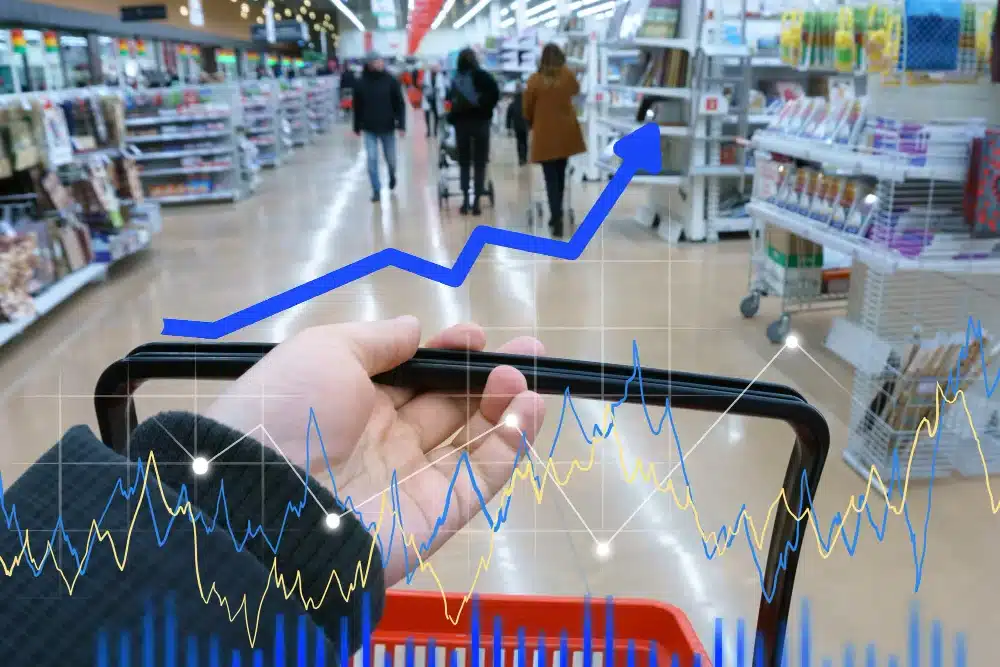In today’s fast-paced world, understanding and meeting customer expectations is paramount. The retail industry is swiftly evolving, thanks to integrating data analytics into various aspects of business operations. From understanding customer behavior to optimizing supply chain management, data analytics has emerged as a powerful tool for retailers aiming to maintain a competitive edge in the market.
Data analytics in retail collects, analyzes, and interprets large volumes of data to uncover patterns and trends. This helps stores make better plans and grow their business. By using data analytics to improve customer experience, stores can make shopping even better for their customers.
It uses advanced technologies and algorithms to extract meaningful insights from vast customer data, such as purchase history, browsing behavior, demographic information, and social media activity.
With the advent of data analytics, retailers now have the power to delve deep into customer insights and tailor experiences to individual preferences. Let’s explore how data analytics revolutionizes retail by enabling personalized customer experiences.
The Importance of Customer Experience in Retail
As a retail business owner, you understand the significance of customer experience in driving customer satisfaction and loyalty. Providing exceptional customer experiences has become a key differentiator in the highly competitive retail industry.
Customers today have high expectations and demand personalized interactions with brands. According to a survey conducted by PWC, in the US, 59% will walk out after having several bad customer experiences. Moreover, 17% will walk out after a single bad customer experience. This number shows the importance of a good customer experience.
Customer analytics in retail has become crucial to meet these expectations and stay ahead of the competition. Data analytics allows you to gain valuable insights into customer behavior, preferences, and needs, which enables you to make informed decisions and create tailored experiences.
How to Improve Customer Experience in Retail Stores Using Data Analytics
Data analytics has revolutionized the retail industry by giving retailers deeper insights into their customers’ behaviors, preferences, and purchasing patterns. With the help of retail customer analytics, retailers can now collect and analyze vast amounts of customer data, including online browsing behavior, purchase history, social media activity, and demographic information.
- Customer Insights Driving Decision-Making
Today, stores rely heavily on data to deeply understand their customers. By studying what customers buy and prefer, stores can group them into different categories. This helps stores create more focused marketing plans. Moreover, by personalizing offers based on how customers behave and what they’ve bought before, stores can make customers happier and more loyal.
For instance, according to a study by McKinsey, personalized marketing campaigns can lead to a sales uplift of 10% to 30%. Personalizing offerings based on individual behavior further boosts customer satisfaction and loyalty, as evidenced by a report from Deloitte, which found that 36% of customers are willing to pay more for personalized products or services.
- Optimizing Inventory Management
Customer data analysis helps stores predict the demand, which further helps them maintain the required stock. By using predictive analytics, stores can change prices accordingly to make more money. This not only makes operations smoother but also ensures customers are happier because products are always available when they need them.
For instance, if data reveals that certain products sell better during specific times of the year, stores can adjust their pricing strategies accordingly, leading to increased sales and profitability. This not only makes operations smoother but also ensures customers are happier because products are always available when they need them.
- Enhancing the In-Store Experience
Stores are using data analytics to make shopping in-store even better. They use beacon technology to send special offers based on where customers are in the store. Also, by looking at how people move around the store and where products are placed, stores can organize things better and offer personalized deals in real time. This makes shopping more enjoyable for customers.
For example, if data shows that certain product displays catch customers’ attention more, stores can put those displays in strategic spots to boost sales and keep customers interested.
- Seamless Omni-Channel Experience
Stores are working hard to make sure that whether customers shop online or in-store, the experience is smooth. By keeping the shopping journey consistent across different ways of shopping, stores make customers happier and more likely to return. According to a study conducted by Deloitte in 2023, Indian retailers are investing in technology and concepts such as BOPIS, BORIS, and endless Aisle,
to drive seamless online-offline connections.
Also, data analytics helps stores find opportunities to suggest more products or services to customers, which helps stores make more money.
- Customer Segmentation and Targeting
Another way data analytics is changing retail is by helping stores understand their customers better. By dividing customers into groups based on factors like age, interests, and what they buy, stores can create marketing campaigns that are just right for each group. This makes marketing more effective and helps stores connect better with their customers.
For instance, if data analysis reveals that younger customers are more interested in technology products while older customers prefer home goods, stores can customize their advertising strategies accordingly. This makes marketing more effective and helps stores connect better with their customers, ultimately leading to increased sales and customer satisfaction.
How to Personalize Customer Experience?
One of the most powerful retail data analytics applications is personalizing the customer experience. By analyzing customer data, retailers can deeply understand individual preferences and behaviors. Thus allowing them to deliver highly personalized experiences at every touchpoint.
For instance, imagine a customer visiting your online store and browsing through various products. Through data analytics, you can track their browsing behavior and use that information to offer personalized discounts based on their interests. This level of personalization makes customers feel valued and understood. Furthermore, it increases their likelihood of making a purchase and fosters loyalty.
Using AI-Driven Data Personalization in Retail
Artificial intelligence (AI) is crucial in leveraging customer data analytics to deliver personalized experiences. AI-powered algorithms can analyze vast amounts of data in real time and make instant recommendations or predictions. This enables retailers to provide personalized recommendations, targeted promotions, and customized product offerings.
For example, AI-driven personalization can enable retailers to create dynamic pricing models that adjust prices based on customer demand, competitor pricing, and inventory levels. This ensures customers receive the best possible price while maximizing the retailer’s profitability.
Case Studies: Successful Examples of Data Analytics in Retail
To illustrate the real-world impact of data analytics in retail, let’s explore a few case studies:
- Amazon
Amazon is a prime example of a company that leverages data analytics to improve customer experience. By analyzing customer browsing and purchase history, they provide personalized product recommendations, tailored search results, and customized marketing emails.
- Starbucks
Starbucks uses data analytics to enhance the customer experience in their mobile app. They analyze customer purchase history and preferences to offer personalized suggestions and rewards. This not only increases customer loyalty but also drives higher sales.
- Sephora
Sephora utilizes data analytics to personalize the in-store experience. By analyzing customer data, they provide personalized beauty recommendations and offer virtual try-on tools to help customers find the perfect products.
Overcoming Challenges in Utilizing Customer Data Analytics
While data analytics for retail offers immense potential for improving customer experiences, there are challenges that retailers must overcome. One major challenge is ensuring data privacy and security. Retailers need to comply with privacy regulations. They also need to protect customer data from breaches and misuse. Retailers must also navigate the complexity of managing and integrating large volumes of data from various sources.
To address these challenges, retailers should invest in robust data governance frameworks, implement stringent security measures, and establish clear policies and procedures for data handling and storage. Partnering with an experienced IT company for data analytics can help retailers leverage their expertise and ensure data compliance.
The Future of Data Analytics in Retail Customer Experiences
As technology evolves, data analytics will play an increasingly vital role in shaping retail customer experiences. Emerging technologies like machine learning, Generative AI, and predictive personalization will enable retailers to anticipate customer needs. Retailers will also leverage augmented and virtual reality to offer immersive and personalized shopping experiences.
Furthermore, integrating data from various touchpoints, such as online and offline interactions, will enable retailers to create seamless omnichannel experiences. Customers will enjoy a consistent and personalized experience across all channels, whether they are shopping online, in-store, or via mobile devices.
Also Read:- Generative AI in Data Analytics: The Next Frontier
Conclusion
In conclusion, data analytics has revolutionized the retail industry by enabling retailers to gain valuable insights into customer behavior. By leveraging customer data analytics, retailers can personalize the customer experience, deliver targeted marketing campaigns, and optimize their operations. While there are challenges in utilizing customer experience data analytics, retailers can overcome them by prioritizing data privacy and partnering with experienced analytics providers. As we look to the future, data analytics will continue to shape retail customer experiences, allowing retailers to stay competitive and meet the ever-increasing expectations of their customers.
Frequently Asked Questions
Data analytics revolutionizes retail customer experiences by providing insights into customer behavior, preferences, and trends. Retailers use this information to personalize offerings, optimize inventory, enhance in-store experiences, and provide seamless omnichannel interactions.
Yes, data analytics can facilitate seamless integration between online and offline channels for retailers. By analyzing customer data across multiple touchpoints, retailers can provide consistent and personalized experiences, enhancing overall customer satisfaction and loyalty.
By leveraging customer data analytics, retailers can expect improved customer satisfaction, increased loyalty, and higher profitability. They can personalize marketing campaigns, optimize inventory management, and offer tailored experiences that resonate with individual customers.
















